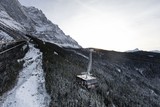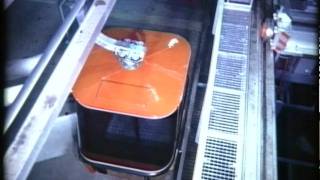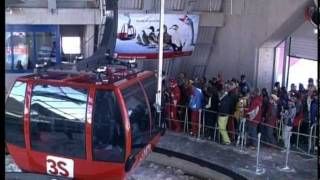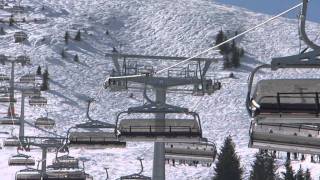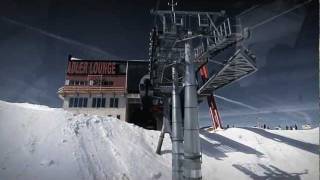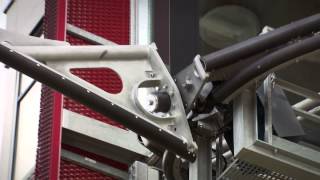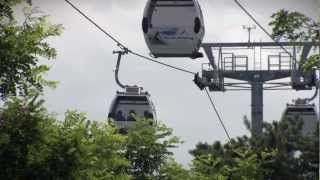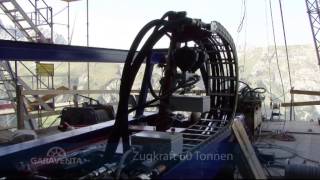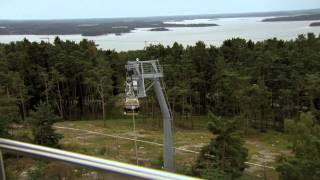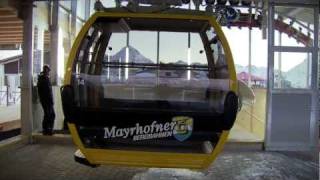Despite experience of building almost 15,000 cable car systems across the globe, the construction of the new Zugspitze cable car was something very special for the Doppelmayr/Garaventa Group. The high availability of the new aerial tramway was one of the greatest challenges for the ropeway engineering company, together with the entire logistics of the project.
Aside from the breathtaking views, visitors to Germany's highest mountain, the Zugspitze, which lies close to Garmisch-Partenkirchen, have been able to enjoy an additional attraction over the past two years – the construction of the summit station for the new Zugspitze cable car. The suspended assembly works for the new summit station were carried out in full view of visitors, directly adjacent to the viewing platform which was sometimes also used as a transit point. Visitors would spontaneously applaud as the assembler, secured on ropes over the precipice of some 1,000 metres, moved around and completed their work. As space was tight at the summit station and the specially built material ropeway had a weight limit of six tonnes, the mechanical parts had already been assembled in the factory in accordance with the given weight limit. The components were then delivered to the summit station on a just-in-time basis and installed.
Tough records to break
In terms of ropeway technology, breaking three world records at once was a particularly challenging feat. The first record concerned the overall altitude difference in one section between the bottom and top stations of just under 2,000 metres. The second named the new Zugspitze cableway as having the longest unsupported span between the single support and the summit station, with a distance of more than 3,200 metres. And last but not least, the cableway was prized with having the world’s highest steel tower for aerial ropeways, measuring 127 metres. There were also a few obstacles to overcome in terms of schedule and logistics. The old Eibsee cable car had to continue running until spring 2017. Now, after just eight and a half months of interruption to operations, the new aerial cable car will go into operation shortly before Christmas 2017. And all of this on a mountain where even in summer it snows at least once a month.
Heavy loads with specifications
A great feat when it came to planning and execution was the transport and installation of the four 150-tonne track ropes. It was not just the route from the plant in Romanshorn to the bottom station near Eibsee, nine kilometres away from Garmisch-Partenkirchen, that had to be carefully planned. It was also the journey times of the heavy loads which were split across two connected freight trains. Once on site, the new track ropes were hoisted up the mountain using the old track ropes from the disused aerial cableway and a special pulling machine. This process involved a tractive force of around 60 tonnes and forces of more than 100 tonnes were at work on the direction change at the top station. The track ropes and haul rope are guided over the new tower, constructed between the two old towers and measuring 127 metres in height. This solution of having one cableway tower instead of two meant that the project could be brought in on budget and the operational costs for the new cable car reduced.
High availability
While the old Eibsee cable car was itself a masterpiece of ropeway technology, the new system also sets new standards. These include, for example, the cabins built by CWA Constructions SA in Olten. Visitors to the Zugspitze can enjoy unrestricted views of their surroundings thanks to the parallelogram-inspired shape of the cable car cabins and their floor-to-ceiling windows. This is even the case in bad weather thanks to built-in window heaters. The angled windows on both the mountain and valley ends and the panoramic windows in the roof guarantee passengers a perfect view of the mountains and valleys and far into the distance. The cabin shape, which is globally unique, and the elegant, understated design blend in perfectly. Capacity has been expanded to 120 people per cabin, making long waiting times to reach the summit a thing of the past. The new Zugspitze cable car is also the first ever cable car to have three carriages. Each of these carriage can be used on both the left and right tracks. This reduces service times when one of the carriage in use needs to be inspected and guarantees the high system availability that is required by the cable car operator.
Technical data
|
Total length |
4,467 m |
|
Altitude difference |
1,945 m |
|
Maximum speed |
10.6 m/s |
|
Track rope Ø |
72 mm |
|
Upper haul rope Ø |
47 mm |
|
Lower haul rope Ø |
41 mm |
|
Rated output, drive |
2 x 800 kW |
|
Transportation capacity |
580 people/h |
Three world records
Highest steelwork support 127 m
Longest unsupported span 3,213 m
Greatest altitude difference in a section 1’945 m
Inquiries
Garaventa AG, Zweigniederlassung Goldau, Tennmattstrasse 15, 6410 Goldau
Phone: 041 859 11 11
contact@garaventa.com
www.garaventa.com
